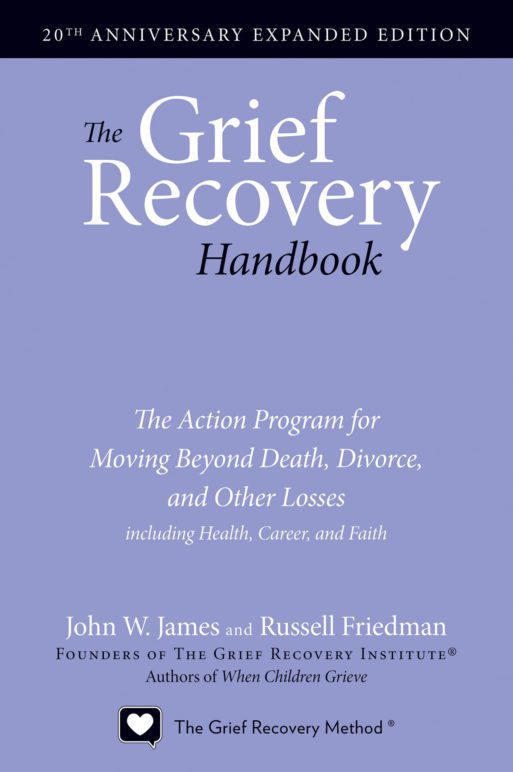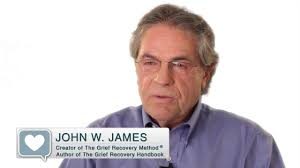 “The Grief Recovery Handbook: The Action Program for Moving Beyond Death, Divorce, and Other Losses Including Health, Career and Faith” has become a classic of the genre, a comprehensive resource guide to dealing with one of the most difficult emotions we have to process in this life. Its authors, John W. James and Russell Friedman, draw upon research and their own experiences of loss to come up with plans of action to move through and come out the other end of shattering experiences. James’s premise is that “with correct information and correct choices, a person can recover from any significant loss.” This book is not an analysis of grief, a journey of intellectualizing the process of recovery. Rather, it is focused on action steps to lead you through the often treacherous waters of recovery.
“The Grief Recovery Handbook: The Action Program for Moving Beyond Death, Divorce, and Other Losses Including Health, Career and Faith” has become a classic of the genre, a comprehensive resource guide to dealing with one of the most difficult emotions we have to process in this life. Its authors, John W. James and Russell Friedman, draw upon research and their own experiences of loss to come up with plans of action to move through and come out the other end of shattering experiences. James’s premise is that “with correct information and correct choices, a person can recover from any significant loss.” This book is not an analysis of grief, a journey of intellectualizing the process of recovery. Rather, it is focused on action steps to lead you through the often treacherous waters of recovery.
The authors make it clear in the first chapter that they don’t believe that intellectualizing grief is the answer, though, they say, we live in a society that socializes us to do so. One cannot recover without confronting emotional pain, and that’s why the authors encourage their readers to “stay open to grief.” They also emphasize in the first chapter that recovery requires action. “Recovery from loss is achieved by a series of small and correct choices made by the griever,” write the authors.

Author John W. James
Credit: griefrecoverymethod.com
Chapter two breaks down what the authors believe are misconceptions about the grieving process. They refrain from using the word “survivor” to describe someone that has outlived someone else, explaining that they believe the word survivor is dangerous because it can end up defining the griever, causing them to constantly revisit the loss that they are attempting to recover from and thus keep them stuck in a rut. The authors warn against the trap of defining yourself by your pain rather than focusing on completing the “unfinished emotional aspects of the relationship” that has been lost. They also deconstruct Elisabeth Kubler-Ross’s five emotional stages of grief. They do not believe that most people who experience a loss are in denial about the loss: “In all our years working with grievers, we have yet to be approach by someone who is in ‘denial’ that a loss has occurred.” They also reject the idea that grief always entails going through an anger stage.
As an alternative to Kubler-Ross’s five stages of grief, the authors present their own list of what they call “common responses.” These include reduced concentration, a sense of numbness, disrupted sleep patters, changed eating habits, and the roller coaster of emotional energy. “There are no stages of grief,” the authors say, and remind their readers that there are no absolutes in grief, “no reactions so universal that all, or even most, people will experience them.” Because every relationship is unique, so is every process of grieving.

Author Russell Friedman
Credit: griefrecoverymethod.com
The book goes on to outline activities for confronting one’s grief head on. One such activity is the charting of a personal loss history graph, designed to help the griever reflect on losses that they’ve experienced and which continue to affect them in their day-to-day lives. The idea is that many people have not actually confronted the grief that they’ve already experienced. This, as they’ve tried to minimize and dismiss their feelings around these losses, unresolved grief continues to have negative impacts on their lives.
The authors also extoll the benefits of working with a partner during the grieving process, ideally someone who is working on their own loss. They then delineate guidelines for partners to talk about feelings and make commitments, such as committing to total honesty and absolute confidentiality.
The first homework assignment the authors give once a grief partnership is established, is to list cultural myths about grieving that limit the ability of a person to effectively deal with grief (a major theme of the handbook). Another homework assignment requires the grief partners to list and discuss “short term energy relievers,” or behaviors that they’ve engaged in to cope with their feelings — such as the excess consumption of food and alcohol and other behaviors that ultimately serve to do nothing more than muffle emotions.
The 20th anniversary expanded edition of this classic includes a new Part Four that contains new material on dealing with loss of faith, loss of career and financial issues, loss of health, and growing up in an alcoholic or dysfunctional home.
I appreciated the practicality of this book’s approach to moving through loss. The authors are able to successfully deliver their practical, action-oriented guidance while maintaining a compassionate voice throughout the book. I felt myself softening in response to their empathic tone, which allowed me to become fully engrossed in the material.

 “The Grief Recovery Handbook, 20th Anniversary Expanded Edition: The Action Program for Moving Beyond Death, Divorce, and Other Losses including Health, Career, and Faith” by John W. James and Russell Friedman
“The Grief Recovery Handbook, 20th Anniversary Expanded Edition: The Action Program for Moving Beyond Death, Divorce, and Other Losses including Health, Career, and Faith” by John W. James and Russell Friedman



 Funeral Favors Offer Visitors a Tangible Memento
Funeral Favors Offer Visitors a Tangible Memento
 “Comeback” by Prince
“Comeback” by Prince















